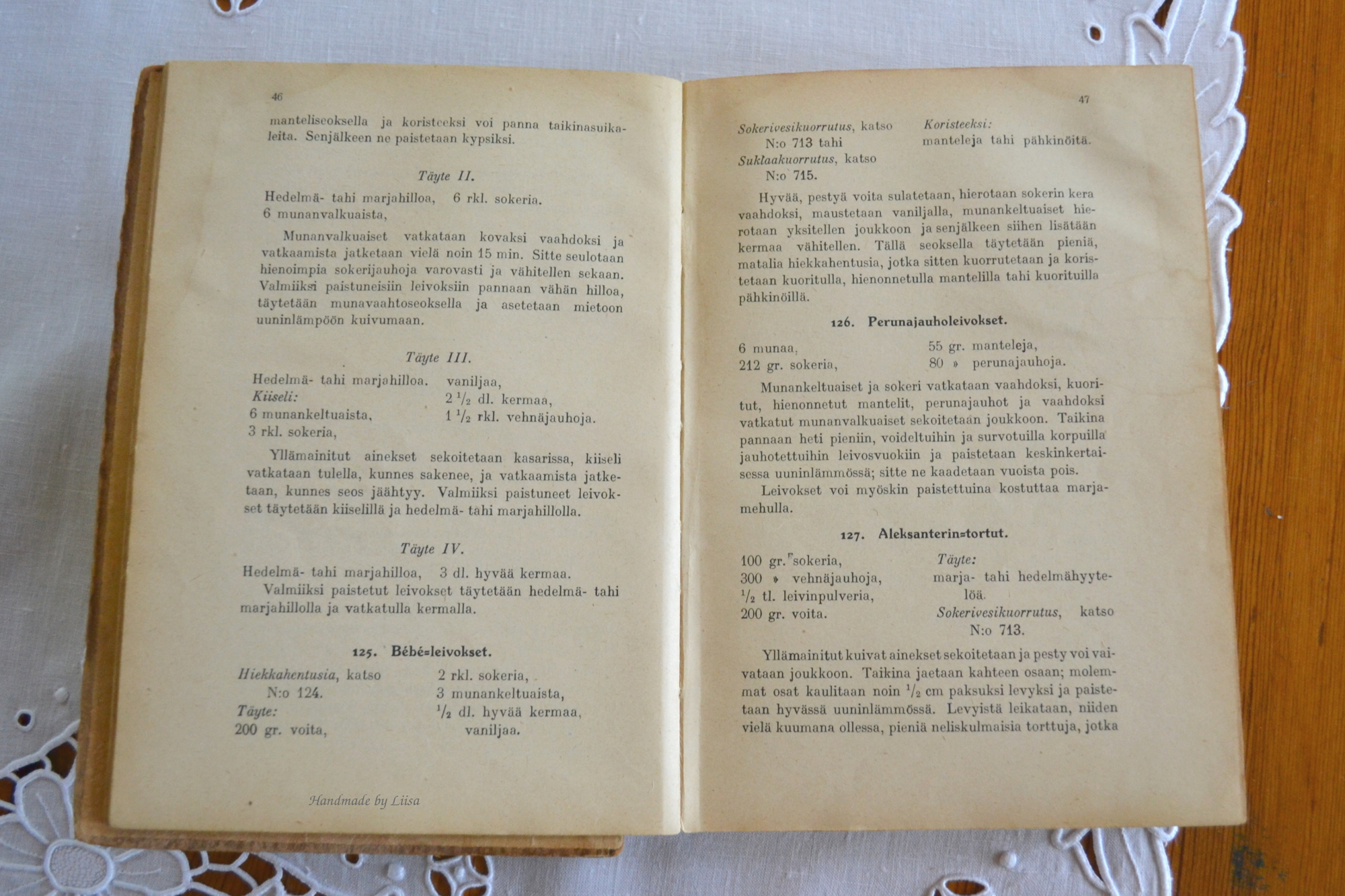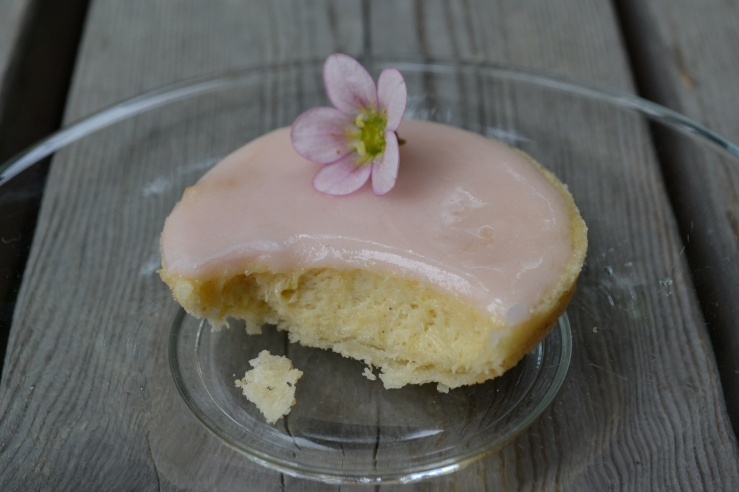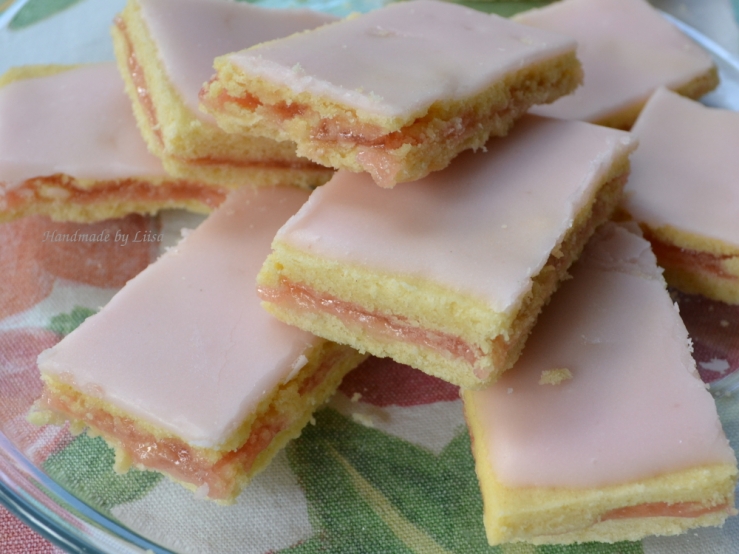
This is my attempt to combine rhubarb, a big favourite of mine, with a classic Finnish buttercream pastry called “Bébé”, which I also love. The Bébé has been around for at least a century – I found the recipe in an old cook book of mine from 1922 🙂
*
Bébé-leivos on valintani kahvilan kakkutiskillä. Raparperi on toinen suosikkini. Tässä kokeiluni yhdistää nämä herkut. Ohjeen bébé-leivoksille löysin vuodelta 1922 peräisin olevasta Kotiruoka – kirjasta (Otavan kahdeksas painos tästä “kotia ja koulua varten” kirjoitetusta keittokirjasta), joten perinteisestä leivokset on kyse 🙂


Ainekset:
Leivospohjiin valmista murotaikinaa tai
1 muna
1 dl sokeria
4,5 dl vehnäjauhoja
200 g voita
Täytteeseen:
150 g voita
1 dl sokeria
1/2 dl kokoon keitettyä raparperimehua, sokeroimatonta
(1 munan keltuainen)
(1 dl raparperihilloketta)
Kuorrutteeseen pari dl tomusokeria ja raparperimehua
Tein tällä kertaa murotaikinan ranskalaisen keittokirjan ohjeen mukaan. Vaahdota kananmuna ja sokeri, sekoita mukaan jauhot ja murusta seos käsien välissä. Hiero voi sekaan jotta saat tasaisen taikinan. Laita se lepäämään jääkaappiin hetkeksi ja kauli sitten ohueksi levyksi jauhotetulle pöydälle. Ota muotilla tai lasilla hieman leivosvuokia isompia pyörylöitä taikinasta ja painele hyvin voideltuihin ja jauhottuihin pikkuvuokiin. Paista 175° kunnes leivospohjat alkavat saada hieman väriä.
Jos leivospohjat kupruilevat uunissa niin voit painella ja tasoittaa niitä lusikalla heti uunista poistamisen jälkeen. Anna pohjien jäähtyä hetki ennen niiden kumoamista. Kokeiluissani huomasin että munaa sisältävät pohjat irtosivat paljon helpommin metallivuoistani kuin vanhan keittokirjan hiekkahentusten reseptillä valmistetut, vain voita, sokeria ja jauhoja sisältävät pohjat. Silikoni tai teflonvuoista ne varmaan irtoavat myös helpommin kuin minun vanhoista metallisista.
Lämmitä täytettä varten kattilassa raparperimehua ja sokeria kunnes sokeri on kokonaan liuennut. Voit myös vispata sekaan keltuaisen jolloin saat vaniljakastikemaisen seoksen ja kreemistä tulee vähemmän voinen. Jätä jäähtymään siksi aikaa kun vaahdotat voin vaaleaksi vaahdoksi, vähintään viisi minuuttia. Vispaa sekaan hyvin jäähtynyt raparperisiirappi tai keltuaisseos. Täytä leivospohjat voikreemillä ja tasoita pinta. Laita jääkaappiin kovettumaan.
Sekoita kuorrutus tomusokerista ja raparperimehusta ja levitä tasaiseksi kerrokseksi leivosten päälle. Raparperista tulee kaunis vaaleanpunainen väri kuorrutukseen jos et kuori punaista pintaa niistä pois. Minä usein keitän pelkkiä kuoria erikseen jotta saan niistä värin talteen.

Tässä erilaisten täytevaihtoehtojen maistelua. Yksi maukas vaihtoehto oli laittaa kreemin päälle raparperimehusta glasyyri kuten ensimmäisessä kuvassa, mutta päädyin lopulta helpompaan vaihtoehtoon eli sekoittamaan hilloketta kreemiin ja kuorruttamaan bébéet perinteiseen tapaan sokerikuorrutteella. Hillokkeen piilottamista pohjan ja kreemin väliin harkitsin myös mutta riskinä olisi pohjan vettyminen. Hilloketta voi myös sekoittaa täytteen joukkoon niin saa vähän raparperisempia leivoksia.

The bébés are made with a pastry crust filled with buttercream and topped with a sugar icing. Traditionally they have a pink coating but a light brown version flavoured with hazelnut is an even more delicious treat that I remember already from my childhood. Now for some rhubarb…
Ingredients:
Short crust pastry or
1 egg
1 dl sugar
4,5 dl flour
200 g butter (I always use salted butter)
For the filling:
150 g butter
1 dl sugar
1/2 dl reduced rhubarb juice, unsweetened
(1 egg yolk)
(1 dl rhubarb compote)
For the icing some icing sugar and rhubarb juice
I tried the French way of making the pastry this time, from my lovely book Toute la Pâtisserie. The pâte sablée is made by first beating the sugar with the egg until light and fluffy. The flour is folded in and then rubbed between your fingers to make it grainy. The soft butter is incorporated and then the pastry is put in the fridge for about ten minutes to set.
Butter and flour you cake molds. Roll the dough out thinly onto a floured work surface. Take small rounds, slightly bigger than your cake molds, and press them into the molds. Bake at 175°C until just starting to colour. Leave to cool a little before unmolding.
For the filling put the rhubarb juice and the sugar into a saucepan and heat gently until the sugar is dissolved. If you want to reduce the amount of butter in the filling you can add an egg yolk to the pan and heat all the ingredients slowly to make a custard. Leave to cool. Beat the butter for at least five ( or ten) minutes to form a white foam, then add the rhubarb syrup or custard. Fill the pastry crusts with this buttercream and even out. Put in the fridge to harden.
Finally coat the little pastries with the icing. These ones got their lovely colour from the juice made with rhubarb skins that simmered in a little water.

I made quite a few versions of these. The one above has some rhubarb compote added to the buttercream, the ones in the first picture have a coating of rhubarb jelly (a bit fiddly) and below some “easy” versions. They are adaptations of the Alexander cake (from a previous post), which by the way is featured on the opposite page from the bébé in the old cook book 🙂

Buttercream mixed with cream cheese in the middle. * Tuorejuustolla jatkettua voikreemiä välissä.

These ones are filled with rhubarb jam. * Raparperihyytelöä täytteenä.

Todella maistuvia olivat, taidonnäytteitä, kiitos.
LikeLike
Kiitos Kirsi 🙂
LikeLike
These look amazing! Rhubarb is always a favorite of mine to cook/bake with and these little “tea cakes” are a winner!
LikeLike
Thanks Treadlemusic! I’m sure you’ll love the rhubarb juice in my next post too – everyone seems to 😀
LikeLiked by 1 person
Looking forward to that!!!
LikeLike